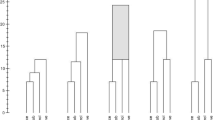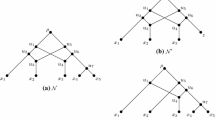Abstract
We introduce in this paper a new clustering structure, parsimonious cluster systems, which generalizes phylogenetic trees. We characterize it as the set of hypertrees stable under restriction and prove that this set is in bijection with a known dissimilarity model: chordal quasi-ultrametrics. We then present one possible way to graphically represent elements of this model.
Similar content being viewed by others
References
Bandelt H-J, Dress WM (1989) Weak hierarchies associated with similarity measures—an additive clustering technique. Bull Math Biol 51: 133–166
Batbedat A (1990) Les approches pyramidales dans la classification arborée. Masson, Paris
Barthélemy J-P, Brucker F (2008) Binary clustering. Discrete Appl Math 156: 1237–1250
Buneman P (1971) The recovery of trees from measures of dissimilarity. In: Kendall DG, Lechevallier Y, Tautu P (eds) Mathematics in archaeological and historical sciences. Edinburgh University Press, Harlow, pp 387–395
Brucker F (2001) Modèles de classification en classes empiétantes. Ph.D. Thesis, EHESS, France
Brucker F (2005) From hypertrees to arboreal quasi-ultrametrics. Discrete Appl Math 147: 3–26
Brucker F (2006) Sub-dominant theory in numerical taxonomy. Discrete Appl Math 154: 1085–1099
Brucker F, Barthélemy J-P (2007) Eléments de Classification. Hermes Publishing, London
Diatta J, Fichet B (1994) From Asprejan hierarchies and Bandelt-dress weak hierarchies to quasi-hierarchie. In: Diday E, Lechevallier Y, Schader M, Bertrand P (eds) New approaches in classification and data analysis. Springer, Berlin, pp 111–118
Diatta J, Fichet B (1998) Quasi-ultrametrics and their 2-balls hypergraph. Discrete Math 192: 87–102
Duchet P (1978) Propriétés de Helly et problèmes de représentations, in Problèmes combinatoires et théorie des graphes. Colloques internationaux du CNRS 260: 117–118
Felsenstein J (1983) Numerical taxonomy. Springer, Berlin
Flament C (1978) Hypergraphes arborés. Discrete Math 21: 223–227
Kelly D, Rival I (1974) Crowns, fences, and dismantlable lattices. Canad J Math 26: 12571271
Legendre P, Makarenkov V (2002) Reconstruction of biogeographical and evolutionary networks using reticulograms. Syst Biol 51: 199–216
Lepouliquen M (2008) Filiation de manuscrits sanskrits par méthodes issues, pour partie, de la phylogénétique. Ph.D., EHESS, Paris
Rival I (1974) Lattices with doubly irreducible elements. Canad Math Bull 17: 91–95
Semple C, Steel M (2003) Phylogenetics. Oxford University Press, New York
Seitou N, Nei M (1987) The neighbor-joining method: a new method for recontruction of phylogenetic tree. Mol Biol Evol 4: 406–425
Tversky A (1977) Features of similarity. Psychol Rev 84: 327–352
Author information
Authors and Affiliations
Corresponding author
Rights and permissions
About this article
Cite this article
Brucker, F., Gély, A. Parsimonious cluster systems. Adv Data Anal Classif 3, 189–204 (2009). https://doi.org/10.1007/s11634-009-0046-7
Received:
Revised:
Accepted:
Published:
Issue Date:
DOI: https://doi.org/10.1007/s11634-009-0046-7




